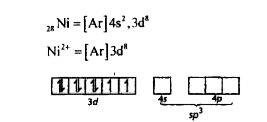Nickel (Z = 28) combines with a uninegative monodentate ligand to form a paramagnetic complex . The number of unpaired electrons in the nickel and geometry of this complex ion are, respectively Solution in Malayalam
one, tetrahedral
two, tetrahedral
one, square planar
two, square planar
The correct Answer is:B

Nickel has two unpared electrons and geometry is tetrahedral due to hybridisation.
Topper's Solved these Questions
- COORDINATION COMPOUNDS BOOK - BRILLIANT PUBLICATIONCHAPTER - COORDINATION COMPOUNDS EXERCISE - LEVEL III (Single Correct Answer Type )
10 Videos
- COORDINATION COMPOUNDS BOOK - BRILLIANT PUBLICATIONCHAPTER - COORDINATION COMPOUNDS EXERCISE - LEVEL III (Multiple Correct Answer Type)
12 Videos
- COORDINATION COMPOUNDS BOOK - BRILLIANT PUBLICATIONCHAPTER - COORDINATION COMPOUNDS EXERCISE - LEVEL I
55 Videos
- CO-ORDINATION COMPOUNDS AND ORGANOMETALLICSBOOK - BRILLIANT PUBLICATIONCHAPTER - CO-ORDINATION COMPOUNDS AND ORGANOMETALLICSEXERCISE - Level-II (Assertion- Reason)
4 Videos
- D & F BLOCK ELEMENTSBOOK - BRILLIANT PUBLICATIONCHAPTER - D & F BLOCK ELEMENTSEXERCISE - Level -II
38 Videos
Similar Questions
A co-ordination complex compound of cobalt has the molecular formula containing five ammonia molecules, one nitro group and two chlorine atoms for one cobalt atom. One mole of this compound produces three mole ions in an aqueous solution, on reacting with excess of AgNO3,AgCl is precipitated. The ionic formula for this complex would be:
View SolutionThe compound(s) that exhibit(s) geometrical isomerism is (are)
View SolutionThe pair of the compounds in which both the metals are in the highest oxidation state is
View SolutionAssertion : The complex ion [Ni(en)3]2+ has lesser stability than [Ni(NH3)6]2+
Reason : ln[Ni(en)3]2+, the geometry is square bipyramidal
View SolutionWhich of the following is not the characteristion of transition metal ?
View SolutionNickel (Z=28) combines with a uninegative monodentate ligand X^(-) to form a paramagnetic complex [NiX_4]^(2-) . The number of unpaired electron(s) in the nickel and geometry of this complex ion are, respectively:
View SolutionNickel (Z=28) combines with a uninegative monodenatate ligands to form a diamagnetic complex [NiL4]2−. The hybridisation involved and the number of unpaired electrons present in the complex are respectively:
View Solutionनिकिल ( Z = 28 ) एक ऋणावेश युक्त मोनोडेन्टेट लीगैंड X− के साथ संयुक्त होकर एक अनुचुम्बकीय जटिल [NiX4]2− बनाता है। निकिल में अयुग्मित इलेक्ट्रॉनों की संख्या तथा जटिल आयन की ज्यामिति क्रमशः है -
View SolutionNickel (Z= 28) combines with a uninegative monodentate ligand X^(-) to form a paramagnetic complex [Nix_(4)]^(2-) . The number of unpaired electron(s) in the nickel and geometry of this complex ion are, respectively :
View SolutionThe oxidation number of nickel in the complex ion [NiCl_4]^(2-) is
View Solutionनिकिल (Z=28) एक एकल ऋणात्मक एक्दंतुक लिगेंड 'X' से सामायोजित होकर एक अनुचुम्बकिये संकुल [NiX4]2− बनाता है| निकिल परमाणु में अयुग्मित एलेक्ट्रोनो की संख्या एवं संकुलों की ज्यामिति क्रमश: है-
View SolutionNickel (Z=28) combines with a uninegative monodenatate ligands to form a diamagnetic complex [NiL4]2−. The hybridisation involved and the number of unpaired electrons present in the complex are respectively:
View SolutionThe oxidation number of Nickel in the complex ion, [NiCl4]2− is
View SolutionNickel combines with a uninegative monodentate ligand X to form a paramagnetic complex [NiX_4]^(2-) . The number of unpaired electron/s in the nickel and geometry of this complex ion are respectively
View SolutionNickel combines with a uninegative monodentate ligand X to form a paramagnetic complex [NiX4]2− . The number of unpaired electron/s in the nickel and geometry of this complex ion are respectively
View SolutionNickel (Z=28) combines with a uninegative monodentate ligand X^(-) to form a paramagnetic complex [NiX_4]^(2-) . The number of unpaired electron/s in the nickel and geometry of this complex ion are respectively _________.
View Solution
